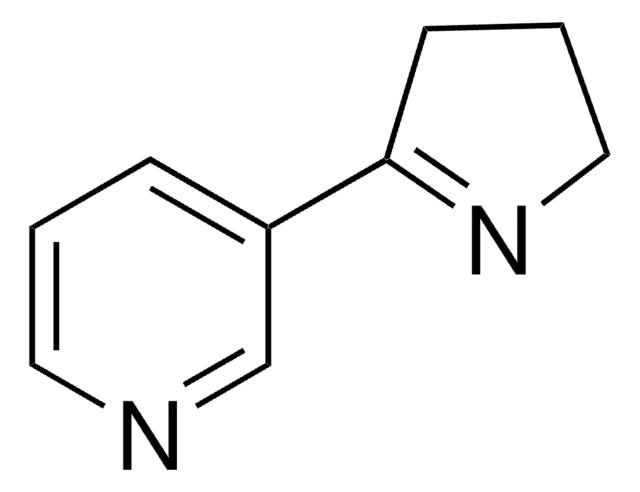This product is nicotine free base and is provided in the form of a neat or pure liquid.
N3876
(−)-Nicotina
≥99% (GC), liquid
Sinónimos:
(−)-1-Metil-2-(3-piridil)pirrolidina, (S)-3-(1-Metil-2-pirrolidinil)piridina
Seleccione un Tamaño
Seleccione un Tamaño
About This Item
Productos recomendados
Quality Level
assay
≥99% (GC)
form
liquid
optical activity
[α]20/D −169°(lit.)
color
yellow
refractive index
n20/D 1.5265 (lit.)
solubility
ethanol: 50 mg/mL
density
1.010 g/mL at 20 °C (lit.)
SMILES string
CN1CCC[C@H]1c2cccnc2
InChI
1S/C10H14N2/c1-12-7-3-5-10(12)9-4-2-6-11-8-9/h2,4,6,8,10H,3,5,7H2,1H3/t10-/m0/s1
InChI key
SNICXCGAKADSCV-JTQLQIEISA-N
Gene Information
human ... CHRNA2(1135) , CHRNA3(1136) , CHRNA4(1137) , CHRNB2(1141) , CHRNB4(1143) , CYP2A6(1548) , KCNH1(3756)
mouse ... Chrna7(11441) , Chrnb1(11443)
rat ... Chrna1(79557) , Chrna2(170945) , Chrna4(25590) , Chrna7(25302) , Chrnb2(54239) , Chrnb4(25103)
¿Está buscando productos similares? Visita Guía de comparación de productos
General description
Application
- para estimular los neutrófilos en ensayos de fluorescencia de ADN extracelular y en inmunotinción de neutrófilos[2]
- para estudiar los efectos de la exposición crónica neonatal a la nicotina en la unión al receptor nicotínico de la acetilcolina (nAChR), la muerte celular y la morfología del hipocampo y el cerebelo[3]
- en un estudio in vitro para evaluar el efecto de la exposición radicular a la nicotina o la cotinina en la morfología y densidad de los fibroblastos[4]
Biochem/physiol Actions
Preparation Note
signalword
Danger
Hazard Classifications
Acute Tox. 1 Oral - Acute Tox. 2 Dermal - Acute Tox. 2 Inhalation - Aquatic Chronic 2 - Eye Dam. 1 - Skin Irrit. 2
Storage Class
6.1A - Combustible acute toxic Cat. 1 and 2 / very toxic hazardous materials
wgk_germany
WGK 3
flash_point_f
213.8 °F - closed cup
flash_point_c
101 °C - closed cup
ppe
Eyeshields, Faceshields, Gloves, type ABEK (EN14387) respirator filter
Elija entre una de las versiones más recientes:
¿Ya tiene este producto?
Encuentre la documentación para los productos que ha comprado recientemente en la Biblioteca de documentos.
-
Is product N3876 (-)-Nicotine considered freebase nicotine or a nicotine salt dissolved in a carrier liquid
1 answer-
Helpful?
-
-
Hi , How i want to measure the purity level of nicotine? Can refractive index or polarimeter use to measure level of impurity?
1 answer-
The measurement of purity in nicotine can be assessed using various analytical techniques. Refractive index and polarimetry are among the methods that can provide useful information. However, it's important to note that these techniques may not directly measure specific impurities but can be indicative of changes in the overall composition or characteristics of a substance. The purity of this product is determined by GC. Gas Chromatography (GC) is a widely used and effective method for assessing the purity of nicotine and detecting impurities. GC separates and analyzes components based on their volatility and interaction with a stationary phase.
Please access a Certificate of Analysis in the DOCUMENTATION section for reference:
https://www.sigmaaldrich.com/product/sigma/n3876#product-documentationHelpful?
-
-
Hello, I would like to know the concentration of the nicotine in this liquid solution.
1 answer-
This product is a neat or pure liquid. Based on the density of 1.02 g/mL and the molecular weight of 162.2 g/mole, the calculated molar concentration is 6.3 M.
Helpful?
-
-
How long is the nicotine stable if stored at room temperature? How long is it stable after being dssiolved and how should the solution be stored?
1 answer-
This compound is stored at room temperature, but is extremely sensitive to light, moisture, and oxygen. The product is a neat liquid and packaged in amber glass under argon to preserve stability. In the unopened container, the product is stable at least until the recommended retest date reported on the lot specific Certificate of Analysis. This date is typically 3 years from the quality release date. Factors such as light, humidity, and exposure to air will limit the shelf life after opening, It is recommended to prepare solutions fresh. The vial head space should be cleared with argon or nitrogen prior to closing. Increased darkening of the material is an indication of product degradation. Please see the link below to review a sample Certificate of Analysis:
https://www.sigmaaldrich.com/certificates/sapfs/PROD/sap/certificate_pdfs/COFA/Q14/N3876-BULKBCCK8089.pdfHelpful?
-
-
what % of ethanol should be used to be solublized?
1 answer-
This product should be dissolved in 200-proof, pure ethanol.
Helpful?
-
-
Where should Product N3876, (-)-Nicotine, be stored and what sensitivities does it have?
1 answer-
For long-term storage, this product can be stored at room temperature. This compound is very hygroscopic and can darken in color on exposure to air and light.
Helpful?
-
-
What is the difference between Nicotine, Products N3876 and N0267?
1 answer-
Prod. No. N3876 is the naturally occurring (-) isomer while Prod. No. N0267 is a mixture of the (+) and (-) isomers.
Helpful?
-
-
What is the molarity of Product N3876, (-)-Nicotine?
1 answer-
The molarity of (-)-Nicotine is 6.23 M based on a 100% pure compound with a density at 20 °C equal to 1.010 g/mL. If you multiply this density by 1000, you obtain g/L. If you divide g/L by the molecular weight of (-)-Nicotine which is 162.2 g/mole, you get moles per L which is molarity. [1.010 x 1000]/162.2 = 6.23 M.
Helpful?
-
-
What is the Department of Transportation shipping information for this product?
1 answer-
Transportation information can be found in Section 14 of the product's (M)SDS.To access the shipping information for this material, use the link on the product detail page for the product.
Helpful?
-
-
How can Product N3876, (-)-Nicotine, be solublized?
1 answer-
Product N3876, (-)-Nicotine, is soluble in ethanol. It is only miscible in water. We would recommend to solublized the product in ethanol to make a 1000x stock solution. This can then be diluted 1:1000 into aqueous buffer for use.
Helpful?
-
Active Filters
Nuestro equipo de científicos tiene experiencia en todas las áreas de investigación: Ciencias de la vida, Ciencia de los materiales, Síntesis química, Cromatografía, Analítica y muchas otras.
Póngase en contacto con el Servicio técnico









